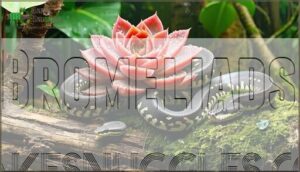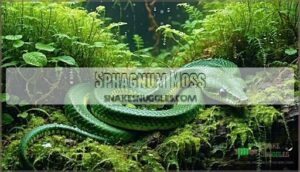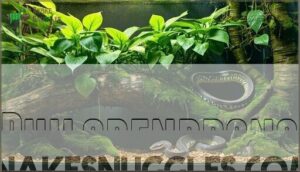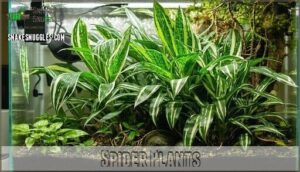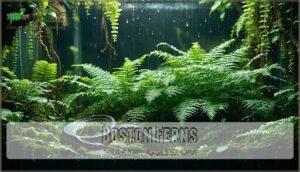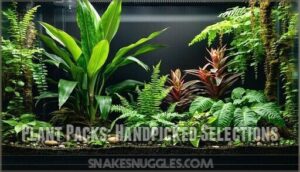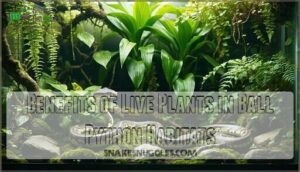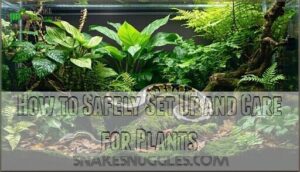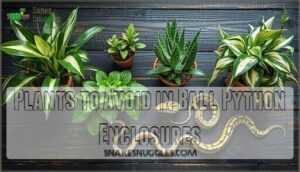This site is supported by our readers. We may earn a commission, at no cost to you, if you purchase through links.
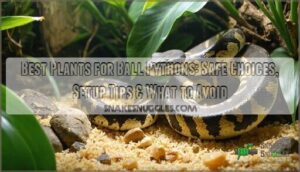 Ball pythons don’t mind if you add a plastic hide and call it a day, but tossing live plants into their enclosure changes everything. You’re not just decorating—you’re engineering a microclimate that regulates humidity, filters air, and triggers natural behaviors your snake evolved to perform.
Ball pythons don’t mind if you add a plastic hide and call it a day, but tossing live plants into their enclosure changes everything. You’re not just decorating—you’re engineering a microclimate that regulates humidity, filters air, and triggers natural behaviors your snake evolved to perform.
The catch? Not every plant survives a 3-pound serpent draping itself across its leaves, and some species harbor compounds that’ll irritate scales or worse. Choosing the right greenery means balancing durability against your python’s steamroller tendencies, matching growth patterns to your maintenance schedule, and double-checking every leaf for hidden toxicity risks that scientific names don’t always advertise upfront.
Table Of Contents
Key Takeaways
- Live plants in ball python enclosures regulate humidity through transpiration, filter air quality, and trigger natural behaviors like climbing and hiding, transforming basic setups into functional microhabitats that support your snake’s instinctive movement patterns.
- The six most durable plant species for ball python enclosures are bromeliads, sphagnum moss, philodendrons, spider plants, Boston ferns, and specialty plant packs, all selected for their ability to withstand a python’s weight while tolerating 50-80% humidity and providing natural cover.
- Four common houseplants pose serious toxicity risks and must be avoided: Dieffenbachia causes oral swelling from calcium oxalate crystals, oleander contains fatal cardiac glycosides, croton triggers gastrointestinal distress, and umbrella plants damage kidneys through insoluble oxalates.
- Successful plant care requires weekly substrate moisture checks, two-week quarantine periods for new specimens to prevent pest introduction, and choosing between bioactive setups with cleanup crews or potted arrangements based on your maintenance commitment level.
Key Factors When Choosing Plants for Ball Pythons
Choosing the right plants for your ball python’s enclosure means looking beyond just what looks good. You’ll want options that support your snake’s health, safety, and natural habits.
Here are the key factors to keep in mind as you select plants for their habitat.
Plant Size and Durability
When you’re picking plants for your ball python’s home, choosing ones that are sturdy enough to bear their weight makes all the difference in keeping the setup safe and long-lasting. Look for durable plants with strong root systems and tough leaves.
Make sure the plant’s lifespan and care requirements fit your routine, and that they’ll offer ground cover and hiding spots without crowding the terrarium.
Non-Toxicity and Safety
Sturdy leaves won’t help if the plants themselves pose hidden dangers. Over 90% of reptile care guides emphasize choosing nontoxic plants backed by veterinary evidence, because even attractive species can trigger serious health issues. Toxicity symptoms like oral swelling or impaired movement can appear within hours of exposure, and soil safety matters too—commercial mixes often contain pesticides or materials that cause impaction. To prevent harm, it’s essential to select reptile safe plants for enclosures.
- Cross-check safe plant lists from regional poison registries before introducing any species to your enclosure
- Quarantine protocols (2–4 weeks minimum) reduce poisoning incidents by over 50% and let you spot problems early
- Chemical risks lurk in fertilizers and potting soil, so rinse roots thoroughly and use organic, reptile-safe substrates
Growth Rate and Maintenance Needs
Even plants that pass every safety check demand your attention—fast-growing species can overwhelm a small enclosure in weeks, while slow growers may need months to establish the hiding cover your snake requires.
Watering frequency and humidity control directly affect growth monitoring, so you’ll adjust care based on lighting conditions and plant health. Pruning techniques keep foliage manageable, while fertilization needs stay minimal in bioactive setups.
Maintaining plant health within reptile enclosures means balancing your snake’s environmental requirements with lighting requirements that support steady, controlled growth.
Compatibility With Ball Python Behavior
Your snake won’t thrive in an enclosure that forces it to compete with its own plants—ball pythons are ambush predators and secretive hiders, so every vine, branch, and leaf cluster must either support or stay clear of their instinctive movement patterns.
Environmental suitability and behavioral impact determine whether snake habitat plants create stress or sanctuary—durable plants for snakes must accommodate, not obstruct.
Choose plants that align with their natural behaviors:
- Climbing support from sturdy vines encourages exploration without breaking under weight
- Burrowing needs dictate low-growing ground cover that won’t collapse hiding spots
- Plant hardiness ensures foliage survives repeated contact while providing enclosure enrichment
Aesthetic Appeal and Enclosure Design
A well-designed enclosure doesn’t just keep your ball python alive—it transforms a plastic box into a miniature ecosystem that looks as natural as it functions.
Naturalistic design through strategic plant placement creates visual harmony while mimicking your snake’s natural habitat.
Ball python terrarium plants, arranged with biotope accuracy, turn a basic reptile enclosure into a themed vivarium that balances function with beauty—your snake benefits from the enrichment, and you get an enclosure worth displaying.
Best Durable Live Plants for Ball Python Enclosures
Not all plants can support a ball python’s weight or thrive in humid enclosures. The right selections need durability, fast growth, and compatibility with your snake’s secretive habits.
Here are six solid options that meet these requirements and simplify setup.
Bromeliads
Bromeliads stand out as one of the most adaptable reptile plants for ball python enclosures. These vivarium plants bring both function and form to your setup:
- Humidity control champion: Their rosettes hold up to 800 mL of water, creating localized moisture pockets your snake will appreciate
- Root disturbance isn’t an issue: Compact root systems stay put even when your ball python moves across them
- Safe for curious snakes: Non-toxic with minimal ingestion risk according to terrarium plant safety data
- Flexible terrarium placement: Naturally epiphytic, so you can mount them or plant them in substrate
With over 3,500 bromeliad varieties available and humidity needs matching typical ball python ranges (50–70%), you’ve got plenty of options for plant selection that won’t compromise safety or durability.
They also improve the enclosure’s aesthetics, offering a naturalistic environment for your ball python.
Sphagnum Moss
For superior Moss Hydration and Humidity Control, sphagnum moss absorbs 16–26 times its dry weight in water, stabilizing moisture levels your ball pythons need.
This Burrowing Medium creates microhabitats that roughly 40% of pythons use in naturalistic setups.
In bioactive terrariums, moss reduces substrate compaction by 73%, supporting root aeration while offering Fungal Suppression that cuts microbial load—completely safe for your reptile habitat.
Philodendrons
Philodendrons offer over 400 varieties, with heartleaf philodendron leading as a resilient choice for ball python enclosures. Choosing safe plants means understanding their strengths:
- Tolerates moderate shade (50–70% light reduction) matching your reptile enclosure conditions
- Sturdy root systems resist uprooting during python activity
- Moderate moisture needs (40–60% retention) simplify care
- Climbing support from sturdy stems supports snake weight
- No documented toxicity to ball pythons despite mammal concerns
This combination of root sturdiness and humidity tolerance makes philodendrons practical for naturalistic setups.
Spider Plants
Spider plants (Chlorophytum comosum) don’t wilt when humidity swings between 40–80%, making them forgiving for ball pythons. Their arching leaves reach 45 cm, creating dense cover, while tuberous roots resist uprooting during snake activity. You’ll see 4–7 new shoots monthly under indirect lighting.
| Feature | Spider Plant Advantage |
|---|---|
| Humidity Tolerance | Tolerates 40–80% fluctuations without stress |
| Root Structure | Tuberous base stays stable during python movement |
| Toxicity | Non-toxic, reptile-safe per herpetological lists |
These reptile-safe plants grow quickly, providing natural hiding spots while tolerating your snake enclosure conditions with minimal fuss.
Boston Ferns
Boston ferns thrive in ball python enclosures that maintain 60–80% humidity—a sweet spot your misting routine should hit three or four times daily to prevent leaf yellowing. Their fronds stretch to 60 cm, blanketing ground space with natural cover, while adapting to stable 22–29°C temperatures without fuss.
Boston fern toxicity isn’t a concern—these reptile enclosure plants are safe, thriving alongside your python while providing lush shelter.
- Humidity Needs: 65–75% best range matches ball python requirements perfectly
- Lighting Requirements: Bright, indirect light for at least 8 hours daily prevents chlorosis
- Frond Length: Mature specimens reach 60 cm, delivering substantial enclosure coverage
- Misting Frequency: Increase to 3–4 times daily at higher humidity thresholds
Plant Packs: Handpicked Selections
If selecting individual specimens feels overwhelming, plant packs for ball pythons simplify your setup with handpicked selections suited to your python’s needs.
Beginner bundles combine durable, non-toxic species like spider plants and bromeliads, while expert collections feature complex bioactive layers with sphagnum moss and themed packs that replicate specific habitats.
Subscription boxes deliver seasonal plantings, ensuring your enclosure evolves with minimal effort.
Benefits of Live Plants in Ball Python Habitats
Adding live plants to your ball python’s enclosure isn’t just about looks—it creates a more functional, healthier habitat.
Plants offer real benefits that support your snake’s well-being and make maintenance easier. Here’s what live plants bring to the table.
Natural Hiding Spots and Enrichment
When you add live plants to your ball python’s enclosure, you’re creating more than decoration—you’re building a network of natural cover that lets your snake feel secure while encouraging exploration. Dense ground cover and strategically placed foliage provide secure hides for these secretive species while offering climbing opportunities that promote natural foraging behavior.
Consider these enrichment benefits:
- Multiple visual barriers reduce stress in captive environments
- Varied plant density creates microhabitats your python can navigate
- Vertical and horizontal vegetation aids natural movement patterns
- Sheltered pathways between plants encourage active exploration
This layered approach transforms your terrarium into an enriching reptile environment.
Humidity and Air Quality Improvement
Live plants don’t just look good—they actively regulate moisture levels through transpiration, releasing water vapor that keeps your ball python’s enclosure in the ideal 50-60% humidity range. This natural process also filters airborne particles, improving air quality by trapping dust and reducing harmful compounds.
In bioactive terrariums, plants work alongside substrate microorganisms to prevent mold growth, creating a self-regulating ecosystem that mimics your python’s natural habitat.
Supporting Natural Snake Behaviors
Beyond creating a stable microclimate, the right plants give your ball python something wild snakes rely on every day—structured pathways for exploration, vertical climbing opportunities, and layered cover that lets them move, hunt, and rest according to their instincts.
Dense ground cover and climbing substrates create hiding opportunities that reduce stress, while varied foliage aids thermoregulation—your python moves between warm and cool zones just as it would in its natural habitat.
These enriching reptile environments encourage natural burrowing and comfort-seeking behaviors essential to their well-being.
Enhancing Terrarium Aesthetics
A well-planted terrarium doesn’t just keep your ball python healthy—it transforms the enclosure into a living display that’s as visually striking as it’s functional.
Thoughtful plant placement creates focal points and visual harmony, while varied color palettes and naturalistic design principles turn your vivarium into a mesmerizing miniature ecosystem.
Strategic layering—from ground cover to taller specimens—builds depth and brings that enriching reptile environment to life.
How to Safely Set Up and Care for Plants
Adding live plants to your ball python’s enclosure requires thoughtful planning to keep both the plants and your snake healthy. You’ll need to balance lighting, watering, and maintenance while making sure the setup promotes your python’s natural behaviors.
Here’s what you need to know about establishing and maintaining a thriving planted environment.
Proper Lighting and Humidity Control
Getting your lighting and humidity dialed in isn’t just about keeping plants alive—it’s about creating a microclimate where both your ball python and its greenery can thrive side by side.
Most tropical species need bright indirect light, so position full-spectrum bulbs to support plant care without overheating your enclosure.
Temperature regulation matters—use monitoring equipment to track humidity gradients and adjust misting systems accordingly. Aim for 50-60% humidity with proper light conditions that satisfy both inhabitants’ needs.
Watering, Fertilizing, and Pruning Tips
Your plant care routine boils down to three essential tasks: water sparingly, fertilize lightly, and prune strategically. Overwatering causes root rot, so wait until the substrate dries slightly between watering sessions.
Use diluted, reptile-safe fertilizer types monthly—excess nutrients can harm both plant and snake.
Trim dead foliage to prevent pest infestations and maintain humidity balance without creating stagnant air pockets.
Pest Prevention and Plant Health Monitoring
Pests don’t announce themselves with fanfare—they slip in silently, feed quietly, and multiply fast if you’re not watching. Check leaves weekly for webbing, discoloration, or tiny crawlers—early pest identification saves your plants and protects your snake.
A cleanup crew of isopods and springtails acts as natural predators in bioactive setups, controlling fungus gnats before infestations spread. Healthy root systems resist diseases better than stressed plants, so monitor plant nutrition and substrate moisture carefully.
Introducing and Quarantining New Plants
Never skip quarantine—bringing a new plant straight into your ball python’s enclosure is like inviting uninspected cargo into a sterile lab. Isolate each plant for at least two weeks, checking daily for pests and diseases that could contaminate your bioactive terrarium setup.
Your quarantine checklist should include:
- Inspect leaves and stems for aphids, mites, or fungal spots
- Replace nursery soil to eliminate potential soil contamination and hidden eggs
- Monitor root health during the acclimation period for rot or infestations
- Watch for observation signs like wilting or discoloration before introduction
This quarantine duration protects both your snake and your cleanup crew.
Bioactive Vs. Potted Plant Setups
Choosing between bioactive and potted setups is like deciding whether to build a self-sustaining ecosystem or maintain a modular garden—each approach offers distinct advantages depending on your commitment level and husbandry goals.
Bioactive terrarium setups require substrate composition with a proper drainage layer and clean-up crews to manage waste, supporting root health naturally while maintaining humidity.
Potted plants in reptile enclosures simplify maintenance and reduce long-term costs, though they demand more frequent monitoring of individual substrate and watering needs.
Plants to Avoid in Ball Python Enclosures
Not every plant belongs in your ball python’s home. Some common houseplants can be toxic if your snake comes into contact with them, while others simply won’t hold up under the weight and movement of a growing python.
Let’s look at which plants you should keep out of the enclosure and how to spot potential problems before they start.
Common Toxic Plants (Dieffenbachia, Oleander, Croton, Umbrella Plant)
Several common houseplants pose serious risks if placed in ball python enclosures. Dieffenbachia contains calcium oxalate crystals that cause severe oral burning and swelling. Oleander holds cardiac glycosides leading to potentially fatal arrhythmias. Croton’s 5-deoxyingenol triggers vomiting, lethargy, and gastrointestinal distress. Umbrella plants damage kidneys through insoluble oxalates.
Preventing poisoning means recognizing these species and choosing safe alternatives instead.
Identifying and Avoiding Harmful Species
Toxic plant ID isn’t always straightforward. Over 30% of enclosures misidentify Dieffenbachia as safe Aglaonema, while variegated Croton and umbrella plants get confused with harmless species in retail guides. Visual misidentification happens frequently with ivy cultivars and ornamental cacti.
Physical plant hazards matter too—cacti cause eye and mouth injuries, and spiny varieties lead to abrasion in 67% of case studies.
Chemical toxicity risks extend beyond Oleander and Dieffenbachia; calcium oxalate crystals account for 28% of serious plant poisoning events.
Safe plant practices include two-week quarantine periods and consulting bioactive vivarium guides.
Tips for Ensuring Plant Safety
Keeping plants safe starts with building a simple verification system before anything green enters your snake’s space. Cross-reference plant toxicity levels through multiple reptile-specific databases, not just garden centers.
Safe sourcing plants means choosing nurseries that avoid pesticide treatments. Follow quarantine protocols—rinse root systems thoroughly and inspect leaf surfaces for residue.
Criteria for reptile-safe plants should prioritize avoiding toxic plants while selecting non-toxic plants that meet pet safety standards.
Frequently Asked Questions (FAQs)
How often should I water the plants in my ball python enclosure?
Watering frequency depends on plant species, humidity balance in your terrarium, and soil moisture levels.
Check substrate weekly—most enclosure plants need water when the top inch feels dry, though environmental suitability varies by care requirements.
Can ball pythons eat plants in their enclosure?
Ball pythons are strictly carnivorous—they won’t intentionally eat plants. However, they might accidentally ingest small amounts while hunting or exploring.
This rarely causes digestion concerns since nontoxic plants pass harmlessly through their system, though avoiding toxic plants remains essential for Ball python care.
How often should I replace live plants?
Replacement depends on plant lifespan and growth conditions in your vivariums.
Healthy plants thriving under proper lighting and humidity may last years. Replace when you notice persistent yellowing, root health decline, or soil depletion despite adequate care.
Do plants need special substrate for ball pythons?
Roughly 70% of bioactive vivariums fail due to improper substrate layering. Plants need substrate designed for drainage and root support—not just ground cover for your snake.
Layer drainage material beneath nutrient-rich soil to prevent root rot while maintaining humidity levels your terrarium requires for both vegetation and snake safety.
Can I use artificial plants instead of live?
Yes, artificial plants work well in your terrarium. They offer Cleaning Ease and Aesthetic Variety without maintenance demands.
However, they don’t improve humidity or air quality like live options, potentially limiting Behavioral Impact and enclosure enrichment.
What temperature range do terrarium plants need?
Most terrarium plants thrive between 70–85°F during the day, matching your ball python’s needs. Nighttime temperature drops to 65–75°F are tolerable.
Use temperature monitoring tools near heating element proximity to prevent scorching.
Indoor environments with proper lighting and humidity maintain these conditions year-round.
Conclusion
Choosing the best plants for ball pythons works like building a living safety net—each species either bolsters your husbandry or creates hidden hazards you’ll troubleshoot for months.
Prioritize non-toxic, sturdy options that withstand compression without leaching harmful compounds, then match their water and light needs to your enclosure’s parameters.
Monitor new foliage for pest activity, adjust humidity gradients as roots establish, and remember that even proven species fail when care protocols slip.
Your python won’t thank you verbally, but consistent shedding cycles and confident movement patterns reveal when you’ve engineered the microclimate correctly.
- https://terrariumtribe.com/safe-plants-for-reptiles/
- https://www.mramphibian.com/safe-plants-for-amphibians/
- https://ucanr.edu/?legacy-file=363609.pdf&legacy-file-path=sites%2Fhdnmastergardeners%2Ffiles%2F
- https://www.frontiersin.org/journals/veterinary-science/articles/10.3389/fvets.2020.00487/full
- https://www.reddit.com/r/ballpython/comments/siafst/toxic_plants_and_ball_pythons_whats_safe_and_what/

